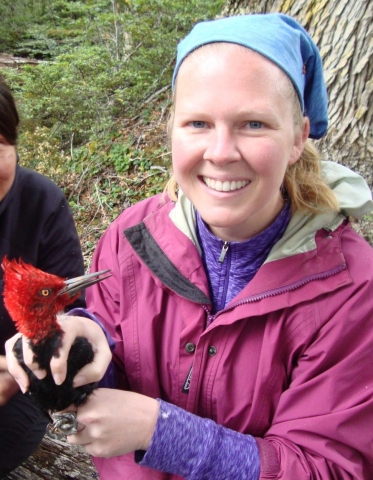Amy Wynia
Doctoral student in Biological Sciences at University of North Texas
I am conducting research on the Magellanic Woodpecker (Campephilus magellanicus, Fig. 1), which is the largest woodpecker in South America (Fig. 2), listed as

Endangered or Vulnerable throughout regions of its Chilean distribution, and culturally important to indigenous groups. Further, this woodpecker is considered a charismatic species, is central for ecotourism, and is a species of conservation interest throughout its range. The Magellanic Woodpecker is endemic to old-growth southern beech (Nothofagus spp.) forests of southern Chile and adjacent Argentina. Evidence indicates that Magellanic Woodpeckers are affected by forest fragmentation by humans and exotic North American beavers (Castor canadensis), and are preyed upon by invasive American mink (Neovison vison).
As primary cavity-nesters, Magellanic Woodpeckers excavate cavities in trees, which provide nest and roost sites for themselves and secondary cavity-nesters that are unable to excavate their own cavities. However, natural cavities, which are created by winds breaking branches from trunks, an increase in decomposing fungi, or fire, do exist. Since Magellanic Woodpeckers provide a habitat component that may otherwise be limited, they are hypothesized to be a keystone species. A keystone species has a disproportionate effect on other species within its ecosystem relative to its biomass or abundance and is often advocated for priority protection; therefore, these woodpeckers are likely vital for contributing to the diversity of taxa (e.g., avian, mammalian, and reptilian) in their ecosystems. Importantly, the Magellanic Woodpecker is the sole cavity excavator on the island.
However, to our knowledge, this hypothesis has never been tested. Therefore, as a first step towards testing this hypothesis, I examined the contents of woodpecker-excavated and natural cavities on Navarino Island, Chile (55°04'60"S, 67°40'00"W) to determine cavity preference by secondary cavity-nesters. As part of a pilot study from January-March 2015, I examined the contents of 90 excavated and 11 natural cavities using a wireless camera and monitor, and an extendable pole.

Several excavated cavities indicated use by other avian species including a down-feathered nest (n = 1), grass nests (n = 2), avian excrement (n = 1), non-woodpecker feathers (n = 3), and twigs (n = 1). Cavities also contained evidence of woodpecker use, including fresh woodchips from excavations (n = 34) and woodpecker feathers (n = 8). Other cavities were empty (n = 13), contained water (n = 1), and unknown contents (n = 8). Eighteen woodpecker excavations were shallow and incomplete; therefore, they were considered platforms and not cavities. Similarly, nine natural cavities were platforms, but two natural cavities contained Austral Parakeet (Enicognathus ferrugineus) nests (Fig. 3).
Although sample sizes are small, 8.9% of excavated and 18.2% of natural cavities were used by secondary cavity-nesters. This indicates that Magellanic Woodpeckers may not serve as a keystone species on Navarino Island, but further research will be conducted for more conclusive results. Additionally, many "cavities" were not fully excavated; therefore, researchers should verify authenticity of each cavity prior to deeming it as such. If occupants are not observed, potential cavities should be further examined to reduce overestimating cavity availability. This information is critical, especially for forest managers, as many species rely on cavities for survival.

If the data collected support my hypothesis, I can provide further support for the protection of the Magellanic Woodpecker and particularly, its habitat. This large woodpecker may also serve as an umbrella species for biodiversity conservation because it has a relatively large home range. Therefore, by protecting this woodpecker and its habitat, many other co-inhabitants will be protected. The conservation of Magellanic Woodpeckers will further allow the development of ecotourism in this unique ecoregion, contribute to local economy, and provide education of the ecological importance of this large woodpecker. This study will also unravel the role of the Magellanic Woodpecker in maintaining the diversity of endemic birds in the world's southernmost forests.